How Smart LEDs Lighting Benefit Color Temperature and Luminosity Transformation
Abstract
:1. Introduction
2. Methods
2.1. Reference Image Setup
2.2. Hyper-Spectral Imaging and Color Reproduction
3. Results and Analysis
3.1. CIE Light Source
3.2. CIE F Light Source
3.3. RGB LED
3.4. OLED
3.5. Analysis on Different Reference Points
3.6. Relationship Analysis
4. Discussion
4.1. Fitting Variables
4.2. Symmetrical Transformations
4.3. Switching Reference Point
5. Conclusion and Future Work
- (1)
- The emitting principle causes CIE and CIEF light sources to exhibit a discontinuous behavior in its relation between luminosity and CCT, making it difficult to conduct further analysis on these light sources.
- (2)
- RGB LED and OLED present an exponential relationship on luminosity and CCT for points with similar visual experience. This relationship can be obtained through a simple regression method and utilized further in transforming luminosity and CCT while maintaining the same visual experience.
- (3)
- Mathematical formulas are constructed under symmetrical principle around the center points. These formulas can be used for quick construction of the relationship between CCT and luminosity under different color differences or center points.
- (4)
- The choice of center points (color reference points) does not affect the relationship between luminosity and CCT. However, we believe that it will affect the valid region of effect.
Acknowledgments
Author Contributions
Conflicts of Interest
References
- De Almeida, A.; Santos, B.; Paolo, B.; Quiheron, M. Solid state lighting review—Potential and challenges in Europe. Renew. Sustain. Energy Rev. 2014, 34, 30–48. [Google Scholar] [CrossRef]
- Humphreys, C.J. Solid-state lighting. MRS Bull. 2008, 33, 459–470. [Google Scholar] [CrossRef]
- Azevedo, I.L.; Morgan, M.G.; Morgan, F. The transition to solid-state lighting. Proc. IEEE 2009, 97, 481–510. [Google Scholar] [CrossRef]
- Tsao, J.Y.; Saunders, H.D.; Creighton, J.R.; Coltrin, M.E.; Simmons, J.A. Solid-state lighting: An energy-economics perspective. J. Phys. D Appl. Phys. 2010, 43, 354001. [Google Scholar] [CrossRef]
- Sun, C.C.; Moreno, I.; Lo, Y.C.; Chiu, B.C.; Chien, W.T. Collimating lamp with well color mixing of red/green/blue LEDs. Opt. Express 2012, 20, A75–A84. [Google Scholar] [CrossRef] [PubMed]
- Crawford, M.H. LEDs for solid-state lighting: Performance challenges and recent advances. IEEE J. Sel. Top. Quantum Electron. 2009, 15, 1028–1040. [Google Scholar] [CrossRef]
- Falchi, F.; Cinzano, P.; Elvidge, C.D.; Keith, D.M.; Haim, A. Limiting the impact of light pollution on human health, environment and stellar visibility. J. Environ. Manag. 2011, 92, 2714–2722. [Google Scholar] [CrossRef] [PubMed]
- Commission Internationale de l’Éclairage (CIE). Method of Measuring and Specifying Colour Rendering Properties of Light Sources; CIE 13.3; Central Bureau of the CIE: Vienna, Austria, 1995; Volume 20, p. 212. [Google Scholar]
- Commission Internationale de l’Éclairage (CIE). Colour Rendering; TC 1–33 Closing Remarks, CIE 135/2; CIE Publication: Vienna, Austria, 1999. [Google Scholar]
- Davis, W.; Ohno, Y. Color quality scale. Opt. Eng. 2010, 49, 033602. [Google Scholar] [CrossRef]
- Chen, L.Y.; Chen, S.H.; Dai, S.J.; Kuo, C.T.; Wang, H.C. Spectral design and evaluation of OLEDs as light sources. Org. Electron. 2014, 15, 2194–2209. [Google Scholar] [CrossRef]
- Yang, X.; Zhou, G.; Wong, W.Y. Recent design tactics for high performance white polymer light-emitting diodes. J. Mater. Chem. C 2014, 2, 1760–1778. [Google Scholar] [CrossRef]
- Ying, L.; Ho, C.L.; Wu, H.; Cao, Y.; Wong, W.Y. White Polymer Light-Emitting Devices for Solid-State Lighting: Materials, Devices, and Recent Progress. Adv. Mater. 2014, 26, 2459–2473. [Google Scholar] [CrossRef] [PubMed]
- Chen, S.; Tan, G.; Wong, W.Y.; Kwok, H.S. White Organic Light-Emitting Diodes with Evenly Separated Red, Green, and Blue Colors for Efficiency/Color-Rendition Trade-Off Optimization. Adv. Funct. Mater. 2011, 21, 3785–3793. [Google Scholar] [CrossRef]
- Komoda, T.; Ide, N.; Varutt, K.; Yamae, K.; Tsuji, H.; Matsuhisa, Y. High-performance white OLEDs with high color-rendering index for next-generation solid-state lighting. J. Soc. Inf. Disp. 2011, 19, 838–846. [Google Scholar] [CrossRef]
- Liu, J.; Zhou, Q.G.; Cheng, Y.X.; Geng, Y.H.; Wang, L.X.; Ma, D.G.; Jing, X.B.; Wang, F.S. The first single polymer with simultaneous blue, green, and red emission for white electroluminescence. Adv. Mater. 2005, 17, 2974–2978. [Google Scholar] [CrossRef]
- Ohno, Y. Spectral design considerations for white LED color rendering. Opt. Eng. 2005, 44, 111302. [Google Scholar] [CrossRef]
- Pardo, P.J.; Suero, M.I.; Pérez, Á.L.; Martínez-Borreguero, G. Optimization of the correlated color temperature of a light source for a better color discrimination. J. Opt. Soc. Am. A 2014, 31, A121–A124. [Google Scholar] [CrossRef] [PubMed]
- Thornton, W.A. Color-discrimination index. J. Opt. Soc. Am. 1972, 62, 191–194. [Google Scholar] [CrossRef] [PubMed]
- Thornton, W.A. A validation of the color-preference index. J. Illum. Eng. Soc. 1974, 4, 48–52. [Google Scholar] [CrossRef]
- Pardo, P.J.; Cordero, E.M.; Suero, M.I.; Pérez, Á.L. Influence of the correlated color temperature of a light source on the color discrimination capacity of the observer. J. Opt. Soc. Am. A 2012, 29, A209–A215. [Google Scholar] [CrossRef] [PubMed]
- Luo, M.R.; Cui, G.; Rigg, B. The development of the CIE 2000 colour-difference formula: CIEDE2000. Color Res. Appl. 2001, 26, 340–350. [Google Scholar] [CrossRef]
- Commission Internationale de l’Éclairage (CIE). A Color Appearance Model for Color Management Systems: CIECAM02; CIE 159; CIE Publication: Vienna, Austria, 2004; Volume 31, p. 158. [Google Scholar]
- Luo, M.R.; Cui, G.; Li, C. Uniform colour spaces based on CIECAM02 colour appearance model. Color Res. Appl. 2006, 31, 320–330. [Google Scholar] [CrossRef]
- Hashimoto, K.; Yano, T.; Shimizu, M.; Nayatani, Y. New method for specifying color-rendering properties of light sources based on feeling of contrast. Color Res. Appl. 2007, 32, 361–371. [Google Scholar] [CrossRef]
- Kruithof, A.A. Tubular luminescence lamps for general illumination. Philips Tech. Rev. 1941, 6, 65–96. [Google Scholar]
- McNelis, J.F.; Howley, J.G.; Dore, G.E.; DeLancy, W.B. Subjective appraisal of colored scenes under various fluorescent lamp colors. Light. Des. Appl. 1985, 15, 25–29. [Google Scholar]
- Fotios, S.; Levermore, G.J. Perception of electric light sources of different colour properties. Light. Res. Technol. 1997, 29, 161–171. [Google Scholar] [CrossRef]
- Ju, J.; Chen, D.; Lin, Y. Effects of correlated color temperature on spatial brightness perception. Color Res. Appl. 2012, 37, 450–454. [Google Scholar] [CrossRef]
- Houser, K.W. Lighting for quality. Light. Des. Appl. 2002, 32, 4–7. [Google Scholar]
- Guo, X.; Houser, K.W. A review of colour rendering indices and their application to commercial light sources. Light. Res. Technol. 2004, 36, 183–197. [Google Scholar] [CrossRef]
- Wei, M.; Houser, K.W. Status of solid-state lighting based on entries to the 2010 US DOE Next Generation Luminaire competition. Leukos 2012, 8, 237–259. [Google Scholar]
- Houser, K.W.; Wei, M.; David, A.; Krames, M.R.; Shen, X.S. Review of measures for light-source color rendition and considerations for a two-measure system for characterizing color rendition. Opt. Express 2013, 21, 10393–10411. [Google Scholar] [CrossRef] [PubMed]
- Boyce, P.R.; Cuttle, C. Effect of correlated colour temperature on the perception of interiors and colour discrimination performance. Light. Res. Technol. 1990, 22, 19–36. [Google Scholar] [CrossRef]
- Hu, X.; Houser, K.W.; Tiller, D.K. Higher color temperature lamps may not appear brighter. Leukos 2006, 3, 69–81. [Google Scholar]
- Wang, H.C.; Chen, Y.T.; Lin, J.T.; Chiang, C.P.; Cheng, F.H. Enhanced visualization of oral cavity for early inflamed tissue detection. Opt. Express 2010, 18, 11800–11809. [Google Scholar] [CrossRef] [PubMed]
- Wang, H.C.; Chen, Y.T. Optimal lighting of RGB LEDs for oral cavity detection. Opt. Express 2012, 20, 10186–10199. [Google Scholar] [CrossRef] [PubMed]
- Wang, H.C.; Tsai, M.T.; Chiang, C.P. Visual perception enhancement for detection of cancerous oral tissue by multi-spectral imaging. J. Opt. 2013, 15, 055301. [Google Scholar] [CrossRef]
- Hsiao, Y.P.; Wang, H.C.; Chen, S.H.; Tsai, C.H.; Yang, J.H. Identified early stage mycosis fungoides from psoriasis and atopic dermatitis using non-invasive color contrast enhancement by LEDs lighting. Opt. Quantum Electron. 2015, 47, 1599–1611. [Google Scholar] [CrossRef]
- Hsiao, Y.P.; Wang, H.C.; Chen, S.H.; Tsai, C.H.; Yang, J.H. Optical perception for detection of cutaneous T-cell lymphoma by multi-spectral imaging. J. Opt. 2014, 16, 125301. [Google Scholar] [CrossRef]
- Jen, C.P.; Huang, C.T.; Chen, Y.S.; Kuo, C.T.; Wang, H.C. Diagnosis of human bladder cancer cells at different stages using multispectral imaging microscopy. IEEE J. Sel. Top. Quantum Electron. 2014, 20, 81–88. [Google Scholar]
- Wang, H.C.; Huang, S.W.; Yang, J.M.; Wu, G.H.; Hsieh, Y.P.; Feng, S.W.; Lee, M.K.; Kuo, C.T. Large-area few-layered graphene film determination by multispectral imaging microscopy. Nanoscale 2015, 7, 9033–9039. [Google Scholar] [CrossRef] [PubMed]
- Wu, I.-C.; Weng, Y.-H.; Lu, M.-Y.; Jen, C.-P.; Fedorov, V.E.; Chen, W.C.; Wu, M.T.; Kuo, C.-T.; Wang, H.C. Nano-Structure ZnO/Cu2O Photoelectrochemical and Self-powered Biosensor for Esophageal Cancer Cell Detection. Opt. Express 2017, 25, 7689–7706. [Google Scholar] [CrossRef] [PubMed]
- Lam, Y.M.; John, H.X. Evaluation of the quality of different D65 simulators for visual assessment. Color Res. Appl. 2002, 27, 243–251. [Google Scholar] [CrossRef]
- Smith, T.; Guild, J. The C.I.E. colorimetric standards and their use. Trans. Opt. Soc. 1931, 33, 73. [Google Scholar] [CrossRef]
- McCamy, C.S. Correlated color temperature as an explicit function of chromaticity coordinates. Color Res. Appl. 1992, 17, 142–144. [Google Scholar] [CrossRef]
- Žukauskas, A.; Vaicekauskas, R.; Shur, M. Solid-state lamps with optimized color saturation ability. Opt. Express 2010, 18, 2287–2295. [Google Scholar] [CrossRef] [PubMed]
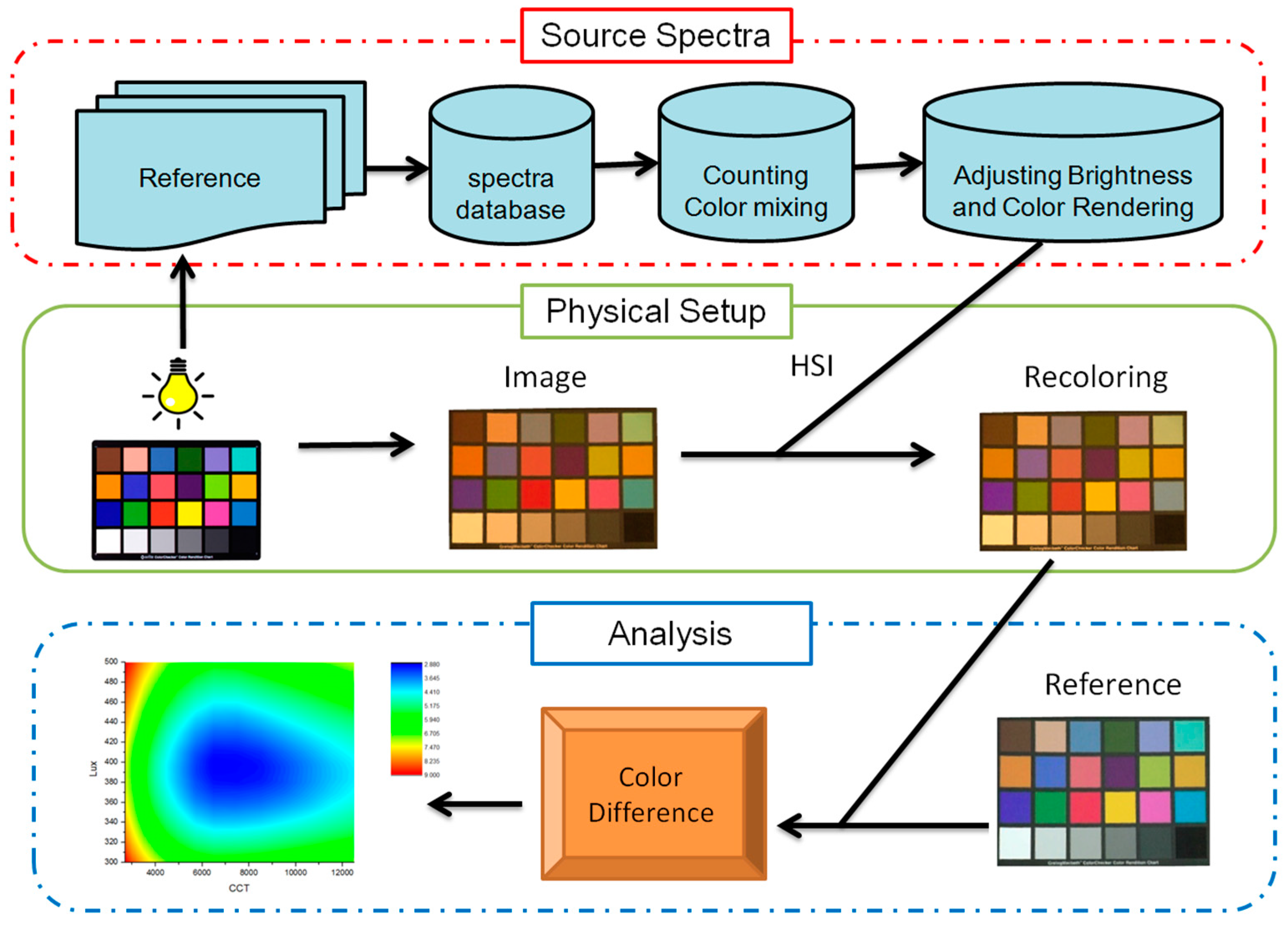
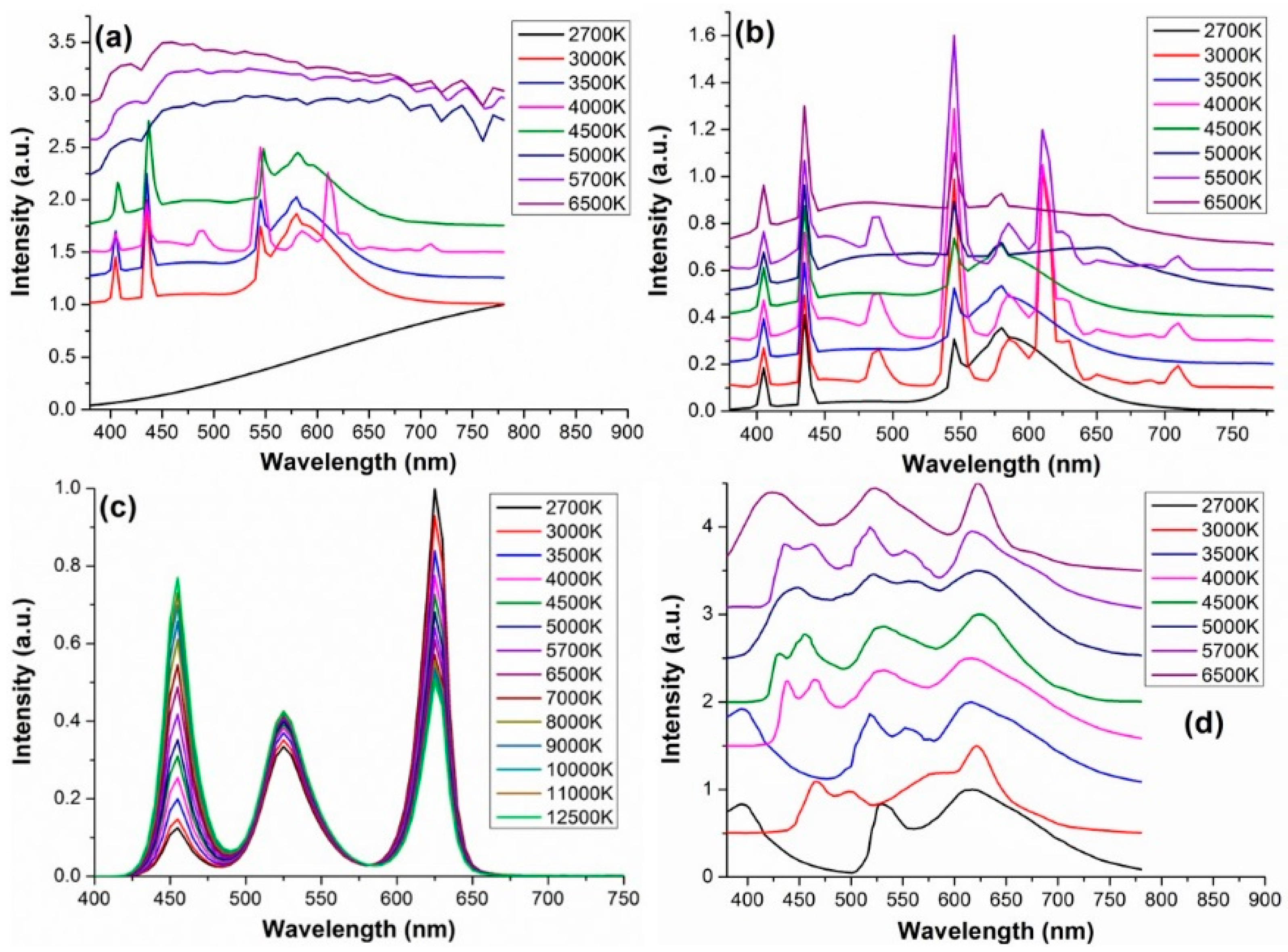

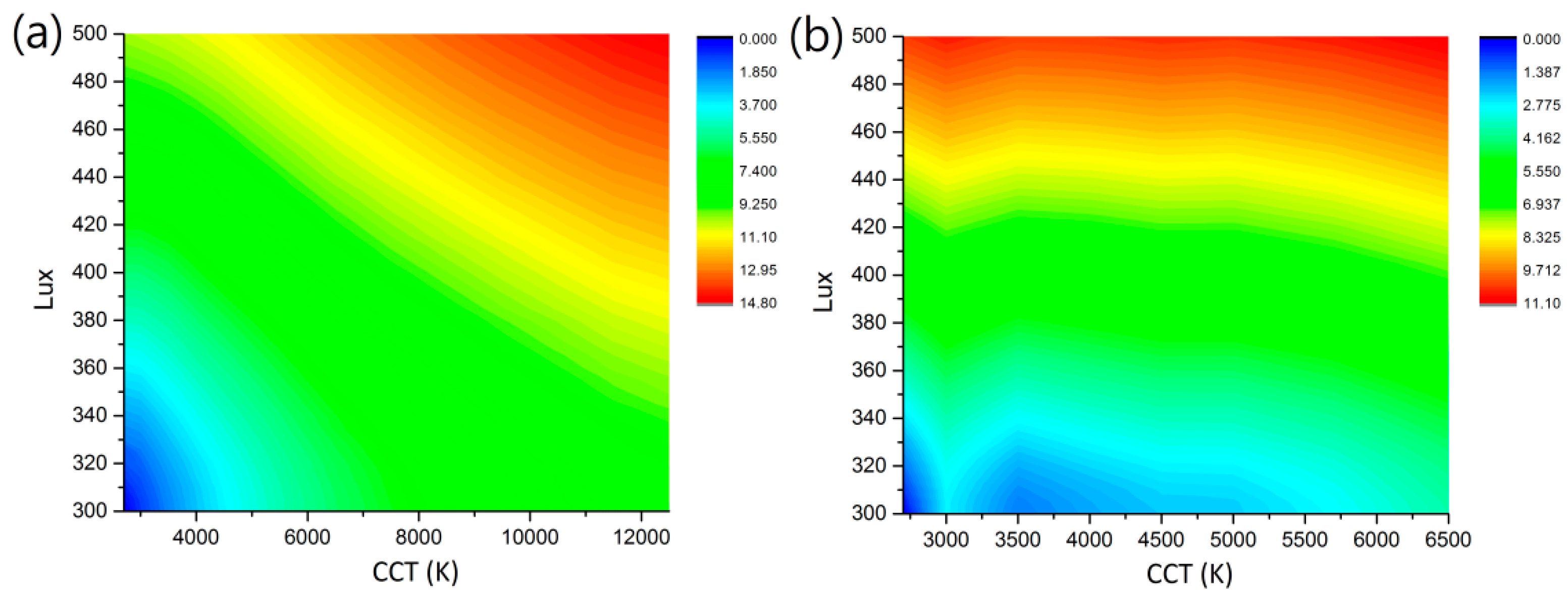
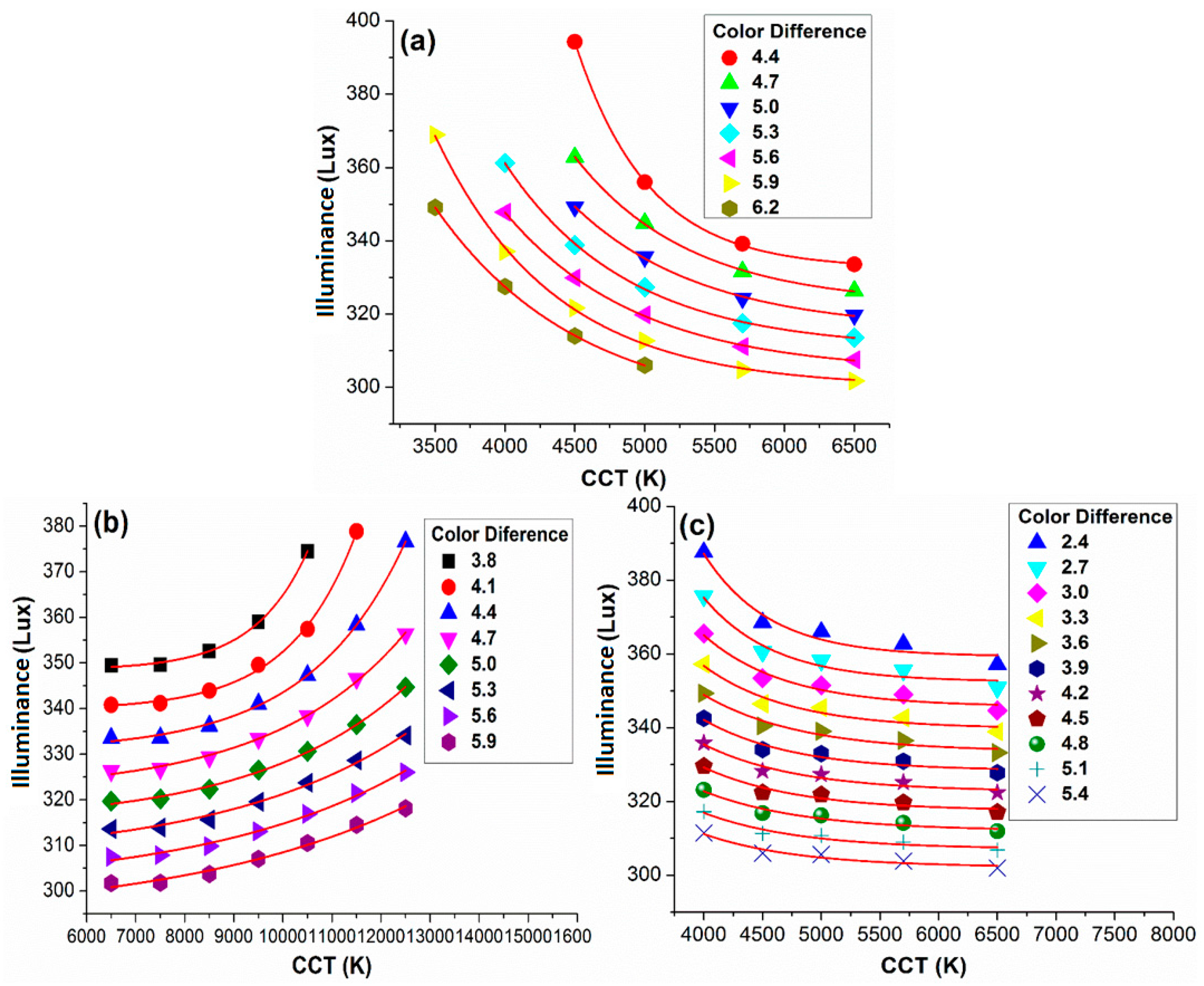
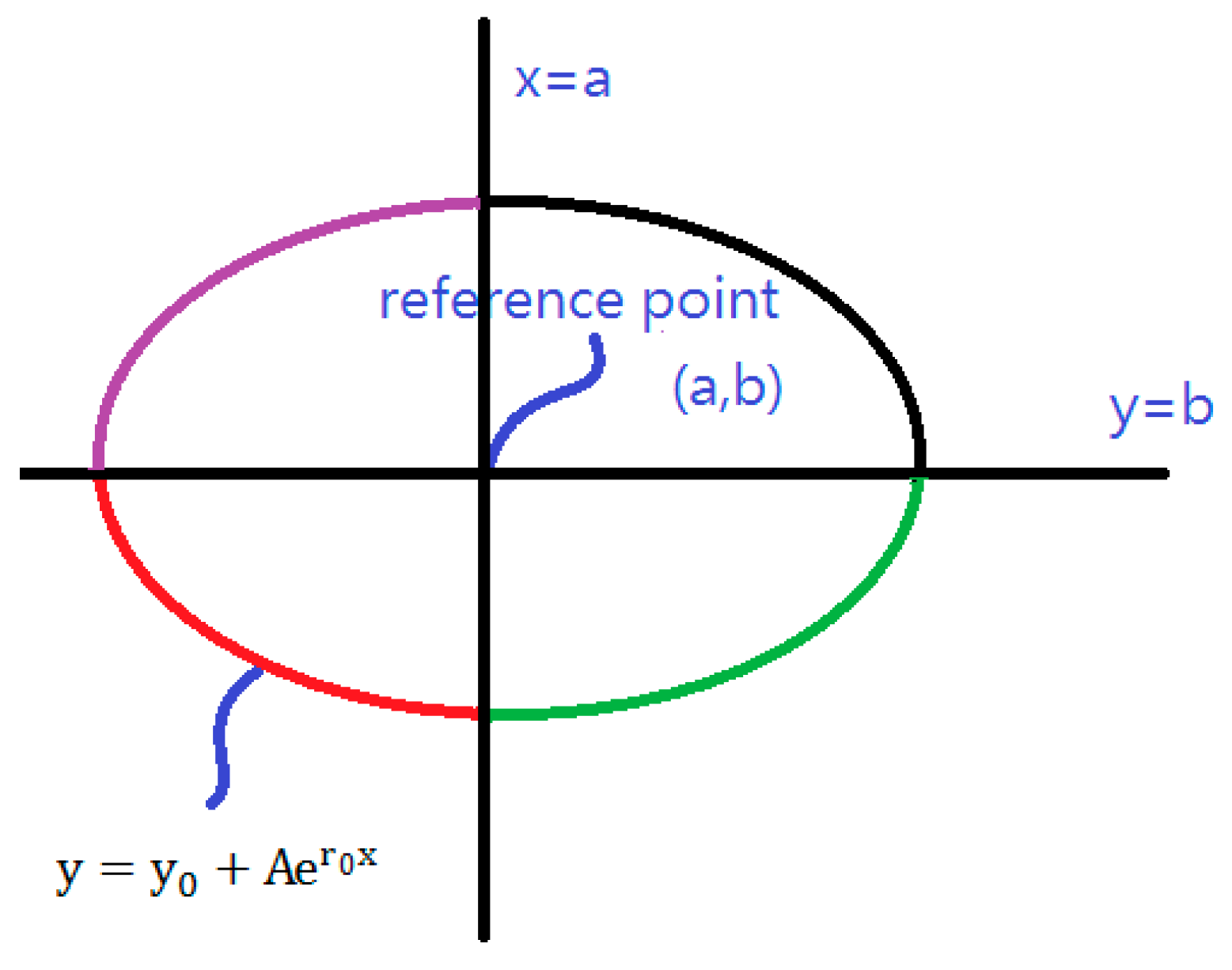
| Exponential Fitting | Form: | |||||
|---|---|---|---|---|---|---|
| Color Difference | y0 | A | r0 | chi | R2 | |
| OLED | ||||||
| 2.4 | 359.3125 | 36,996.66 | −0.0018 | 9.74213 | 0.92705 | |
| 2.7 | 352.4438 | 18,190.29 | −0.00167 | 6.16192 | 0.92993 | |
| 3 | 345.7124 | 6373.249 | −0.00145 | 4.80766 | 0.92172 | |
| 3.3 | 339.712 | 4112.206 | −0.00137 | 4.65922 | 0.90131 | |
| 3.6 | 333.4818 | 1983.748 | −0.00121 | 2.63293 | 0.92772 | |
| 3.9 | 328.3302 | 2704.68 | −0.00132 | 2.69962 | 0.91125 | |
| 4.2 | 322.6771 | 1813.023 | −0.00124 | 2.18214 | 0.91401 | |
| 4.5 | 317.4525 | 1684.778 | −0.00124 | 2.22738 | 0.89761 | |
| 4.8 | 312.0153 | 1156.717 | −0.00117 | 1.59685 | 0.90941 | |
| 5.1 | 307.0783 | 1325.591 | −0.00123 | 1.43558 | 0.90484 | |
| 5.4 | 302.1877 | 1278.015 | −0.00124 | 1.37708 | 0.8913 | |
| RGB LED | 6500 K–12,500 K | |||||
| 3.8 | 348.4514 | 0.00169 | 9.18 × 104 | 0.17738 | 0.99838 | |
| 4.1 | 339.7523 | 0.00738 | 7.45 × 104 | 0.71652 | 0.99663 | |
| 4.4 | 330.6664 | 0.07979 | 5.08 × 104 | 0.31164 | 0.99877 | |
| 4.7 | 321.7622 | 0.35676 | 3.67 × 104 | 0.37569 | 0.99702 | |
| 5 | 314.8159 | 0.51721 | 3.25 × 104 | 0.32119 | 0.99628 | |
| 5.3 | 307.0196 | 1.04373 | 2.62 × 104 | 0.63982 | 0.98967 | |
| 5.6 | 300.7108 | 1.256 | 2.42 × 104 | 0.45611 | 0.99101 | |
| 5.9 | 293.7972 | 1.81156 | 2.09 × 104 | 0.63311 | 0.98469 | |
| RGB LED | 4000 K–6500 K | |||||
| 4.4 | 332.481 | 338,411.1 | −0.00191 | 0.34216 | 0.99955 | |
| 4.7 | 322.6118 | 9543.561 | −0.00122 | 0.26837 | 0.99898 | |
| 5 | 315.68 | 4580.892 | −0.00109 | 0.43825 | 0.99748 | |
| 5.3 | 310.5442 | 4810.612 | −0.00114 | 0.32832 | 0.99911 | |
| 5.6 | 304.1548 | 2904.569 | −0.00105 | 0.15723 | 0.9994 | |
| 5.9 | 299.9801 | 4196.213 | −0.00117 | 0.82672 | 0.99871 | |
| 6.2 | 293.0498 | 1721.424 | −9.78 × 104 | 0.0214 | 0.99994 | |
© 2017 by the authors. Licensee MDPI, Basel, Switzerland. This article is an open access article distributed under the terms and conditions of the Creative Commons Attribution (CC BY) license (http://creativecommons.org/licenses/by/4.0/).
Share and Cite
Huang, Y.-S.; Luo, W.-C.; Wang, H.-C.; Feng, S.-W.; Kuo, C.-T.; Lu, C.-M. How Smart LEDs Lighting Benefit Color Temperature and Luminosity Transformation. Energies 2017, 10, 518. https://doi.org/10.3390/en10040518
Huang Y-S, Luo W-C, Wang H-C, Feng S-W, Kuo C-T, Lu C-M. How Smart LEDs Lighting Benefit Color Temperature and Luminosity Transformation. Energies. 2017; 10(4):518. https://doi.org/10.3390/en10040518
Chicago/Turabian StyleHuang, Yu-Sheng, Wei-Cheng Luo, Hsiang-Chen Wang, Shih-Wei Feng, Chie-Tong Kuo, and Chia-Mei Lu. 2017. "How Smart LEDs Lighting Benefit Color Temperature and Luminosity Transformation" Energies 10, no. 4: 518. https://doi.org/10.3390/en10040518
APA StyleHuang, Y.-S., Luo, W.-C., Wang, H.-C., Feng, S.-W., Kuo, C.-T., & Lu, C.-M. (2017). How Smart LEDs Lighting Benefit Color Temperature and Luminosity Transformation. Energies, 10(4), 518. https://doi.org/10.3390/en10040518






